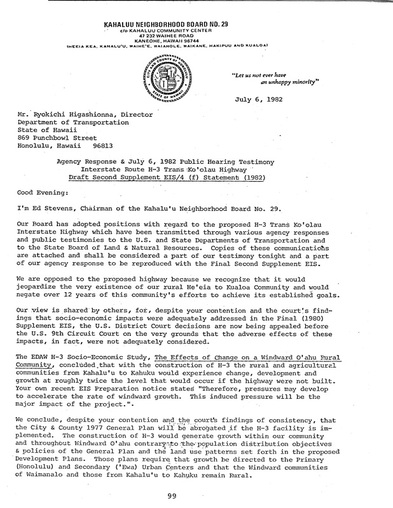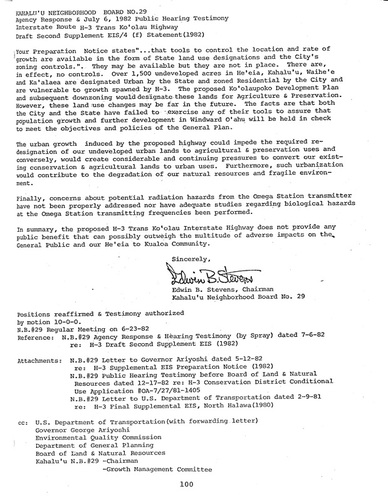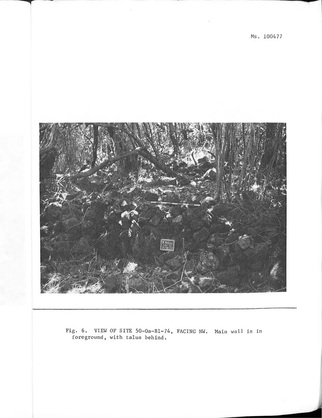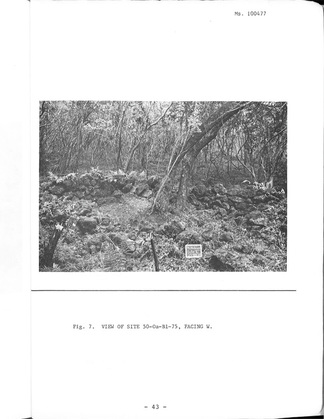4 Major Problems For The H-3
During the surveys conducted as early as the late 1960’s, surveyors found a maximum of seventeen archeological sites of significance deemed worthy of preservation. The raised the question of “will the H-3 disrupt archeologically important sites?” was asked after the some of the first surveys results came in. contained in one of the surveys revealed as many as nine sites identified in one of the loops labeled “Ramp B” in the H-3 (Draft Third Supplement to the Interstate H-3 Environmental Impact Statement). Then in another survey as many as seven sites were found to be within the highways vicinity along with another four on the Windward side of the H-3.TH-3 alternative (Draft Supplement to the Interstate H-3 Environmental Impact Statement page 69-72 maps). With this information local communities suddenly got involved. One testimony from Ed Stevens, chairmen of the Kahulul’u neighborhood board shows the communities concerns in rising situations. He said “We are opposed to the proposed highway [H-3] because we recognize that it would jeopardize the very existence of our rural He’eia to [the] Kualoa community and would negate over 12 years of this communities efforts to achieve its established goals” (Final Supplement to the Interstate H-3 Environmental Impact Statement page 99 para 2). One major citing was a reference to site designation G5-71. It says, “Local residents consider site G5-71 a shrine; the archeological to date suggests only that it may date to the historic period” (Draft Third Supplement to the Interstate H-2 Environmental Impact Statement, Section G-4 para 2). Although these impact statements are conveying real information to help the decision making process of building or not to building the H-3 or the TH-3, there are many errors that local residents cite to prove the point that if information cannot be clearly presented, H-3 should not be built for fear of wronged information. One notable error was addressed by the Department of Land and Natural Resources, it a letter to a Mr. H. Kusumoto it read, “The region IX staff analysis (1979) needs to be corrected (page D-50).” “Skunks are not a primary form of wildlife in Hawaii.” “Perhaps staff meant Skinks.” (Final Supplement to the Interstate H-2 Environmental Impact Statement page 86 para 5).
Once the communities got involved many assumed the position of being against or opposed to construction of the H-3. Although the vast majority were against, some sided in favor of building H-3. The biggest point on the opposing side was that H-3 would modernize local communities like Kaneohe so fast that local businesses wont be able to keep up. Among other issues was water quality. In one testimony Marguerite Peach, a private citizen said, “The second supplement does not cover impacts on water. The highway will affect stream percolation and cause a loss of water resources when tunneling through dikes in the Ko’olau’s. Wilson Tunnel [for example] still leaks and the problem will be greater with H-3” (Final Supplement to the Interstate H-3 Environmental Impact Statement Page 197 para 2). With a vast majority of people opposing the H-3, s very small amount favored H-3. Kenneth Takenaka of the Construction Industry Legislative Organization cited one counter testimony. He said, “Draft Supplement satisfactorily addresses judge kings decision. H-3 is needed and will serve 1/3 of trans-ko’olau traffic and will also aid Hawaii’s swamped economy.” Although Mr. Takenaka wanted to be in favor he was quickly responded to when someone said “But you are a construction worker, the H-3 project will provide you and your organization with jobs and economic stimulant, not those of an average citizen.” (Final Supplement to the Interstate H-3 Environmental Impact Statement Page 195). With one side against H-3 and another in favor of H-3, an even smaller number chose no side, but just wanted to address key issues. One testimony came from a private citizen named Fred Hertlein who said, “I am not in agreement with the state experts in regard to the effect of electromagnetic radiation. We don’t know anything about what 10 kilohertz radiation has on human beings. Experts are using extrapolations. Long term genetic effects and neurophysiological effects have not been studied. An epidemiological survey is the only rational way to conduct these studies.” (Final Supplement to the Interstate H-3 Environmental Impact Statement Page 202).
Among the archeological sites in the area of H-3, other surveys accounted for Hawaii’s diverse Native plant and animal habitats in and around H-3. There is no doubt that H-3 would and will affect plant and animals indirectly. In one of the EIS statements it stated, “It is clear that native bird populations in North Halawa Valley will diminish significantly as a result of highway construction and operation” (Draft Supplement to the Interstate H-3 Environmental Impact Statement Page 153 Para 3). If the proposed H-3 was to “significantly” alter the bird populations then why was it approved? One of the biggest counter statements was also stated in the same particular EIS. It stated, “Previous human use of the valley and a host of introduced mammals [mongoose, rats, and pigs in particular] have contributed to the change in landscape of this and virtually every other forested valley on the leeward slopes of the Ko’olau mountain range” (Draft Supplement to the Interstate H-3 Environmental Impact Statement Page 150 Para 1). In the valleys many native birds called the valley home. One called the Edible-nest Swiftlet was known in recent years [following the survey] was noted in the area so close to the proposed H-3 that even the survey questioned if the population would survive construction (Draft Supplement to the Interstate H-3 Environmental Impact Statement Page 153 Para 1). In the proposed valley area animals were not the only ones to be directly impacted by construction. Plants also suffered from heavy machinery and the eventual highway itself. In two maps in the EIS showed mostly “tall grasses” (Draft Supplement to the Interstate H-3 Environmental Impact Statement Page 64 Figure III-5) and “shrubs” (Draft Supplement to the Interstate H-3 Environmental Impact Statement Page 64 Figure III-5) but in one map, it showed “exotic plants covered by forestry”(Draft Supplement to the Interstate H-3 Environmental Impact Statement Page 64 Figure III-5) although the EIS does not specify the scarcity and abundance of the “exotic plants” (Draft Supplement to the Interstate H-3 Environmental Impact Statement Page 64 Figure III-5). The second map shows a good amount of “native, exotic, and invader” plants (Draft Supplement to the Interstate H-3 Environmental Impact Statement Page 63 Figure III-4).
With the issues mainly facing archeological sites and plant and animal disturbances, there was one more major issue, The OMEGA station. As stated above with the testimonies regarding the OMEGA station many local residents didn’t want a highway passing close to a facility that radiated electromagnetic radiation onto motorist, construction workers, and vehicles. Many EIS statements concluded that there is a risk of radiation, but never suggested there would be anything done about it. This was clearly stated in Paul Lane’s letter to Mr. H Kusumoto [Division Administrator U.S Department of Transportation Federal Highway Administration] dated July 15 1982. Lane’s letter was in regard to a past survey conducted and concluded by Arthur Guy in May of 1982. Lane’s stated two concerns about Guys survey. “Concern one: There is no agreement on what safe level is for the Peacemaker Generators [The Peacemaker Generator was planned to be installed in the OMEGA station, these are what emitted Electromagnetic Radiation].” (Final Supplement to the Interstate H-3 Environmental Impact Statement page 142 para 3). The Second concern in Lane’s letter stated, “Concern two: There is no statement in the proposed plans that indicate that there WILL be shielding, only that shielding COULD be used to reduce the field intensity” (Final Supplement to the Interstate H-3 Environmental Impact Statement page 142 para 4). The issues regarding the OMEGA station was already losing interest in some congressmen, but once media covered the story, even more local residents pushed for the disapproval of H-3. In one newspaper clipping the Star Bulletin addressed “Fatal Shocks” from radiation if the H-3 was built. Once released to the public, local support for the H-3 project dropped lower (Draft Third Supplement to the Interstate H-3 Environmental Impact Statement No Page, 18 Pages from back of book Newspaper clipping). Because of the coverage and dramatic issues regarding the Peacemaker Generators and the OMEGA station were so widely conveyed, the public began speaking out. In a four paged another letter to Mr. H Kusumoto from Charles Reppun, President of the Hui Malama Aina O’koolau he stated that there needs to be shielding if the H-3 is to be built. Otherwise motorist will be exposed to EMR (Electromagnetic Radiation) and will cause unknown illnesses. EMR will also affect vehicles in an “adverse” way. Finally construction workers would need to be shielded. All this shielding would cost a substantial addition of spending money into the already expensive project (Final Supplement to the Interstate H-3 Environmental Impact Statement page 129 para 2). He also stated a reference to Arthur Guys survey. He states that a “reputable” scientist like Dr. Guy should be able to conduct experiments on more then one subject [Peacemakers] and of different companies (Final Supplement to the Interstate H-3 Environmental Impact Statement page 129 para 3).
Once the communities got involved many assumed the position of being against or opposed to construction of the H-3. Although the vast majority were against, some sided in favor of building H-3. The biggest point on the opposing side was that H-3 would modernize local communities like Kaneohe so fast that local businesses wont be able to keep up. Among other issues was water quality. In one testimony Marguerite Peach, a private citizen said, “The second supplement does not cover impacts on water. The highway will affect stream percolation and cause a loss of water resources when tunneling through dikes in the Ko’olau’s. Wilson Tunnel [for example] still leaks and the problem will be greater with H-3” (Final Supplement to the Interstate H-3 Environmental Impact Statement Page 197 para 2). With a vast majority of people opposing the H-3, s very small amount favored H-3. Kenneth Takenaka of the Construction Industry Legislative Organization cited one counter testimony. He said, “Draft Supplement satisfactorily addresses judge kings decision. H-3 is needed and will serve 1/3 of trans-ko’olau traffic and will also aid Hawaii’s swamped economy.” Although Mr. Takenaka wanted to be in favor he was quickly responded to when someone said “But you are a construction worker, the H-3 project will provide you and your organization with jobs and economic stimulant, not those of an average citizen.” (Final Supplement to the Interstate H-3 Environmental Impact Statement Page 195). With one side against H-3 and another in favor of H-3, an even smaller number chose no side, but just wanted to address key issues. One testimony came from a private citizen named Fred Hertlein who said, “I am not in agreement with the state experts in regard to the effect of electromagnetic radiation. We don’t know anything about what 10 kilohertz radiation has on human beings. Experts are using extrapolations. Long term genetic effects and neurophysiological effects have not been studied. An epidemiological survey is the only rational way to conduct these studies.” (Final Supplement to the Interstate H-3 Environmental Impact Statement Page 202).
Among the archeological sites in the area of H-3, other surveys accounted for Hawaii’s diverse Native plant and animal habitats in and around H-3. There is no doubt that H-3 would and will affect plant and animals indirectly. In one of the EIS statements it stated, “It is clear that native bird populations in North Halawa Valley will diminish significantly as a result of highway construction and operation” (Draft Supplement to the Interstate H-3 Environmental Impact Statement Page 153 Para 3). If the proposed H-3 was to “significantly” alter the bird populations then why was it approved? One of the biggest counter statements was also stated in the same particular EIS. It stated, “Previous human use of the valley and a host of introduced mammals [mongoose, rats, and pigs in particular] have contributed to the change in landscape of this and virtually every other forested valley on the leeward slopes of the Ko’olau mountain range” (Draft Supplement to the Interstate H-3 Environmental Impact Statement Page 150 Para 1). In the valleys many native birds called the valley home. One called the Edible-nest Swiftlet was known in recent years [following the survey] was noted in the area so close to the proposed H-3 that even the survey questioned if the population would survive construction (Draft Supplement to the Interstate H-3 Environmental Impact Statement Page 153 Para 1). In the proposed valley area animals were not the only ones to be directly impacted by construction. Plants also suffered from heavy machinery and the eventual highway itself. In two maps in the EIS showed mostly “tall grasses” (Draft Supplement to the Interstate H-3 Environmental Impact Statement Page 64 Figure III-5) and “shrubs” (Draft Supplement to the Interstate H-3 Environmental Impact Statement Page 64 Figure III-5) but in one map, it showed “exotic plants covered by forestry”(Draft Supplement to the Interstate H-3 Environmental Impact Statement Page 64 Figure III-5) although the EIS does not specify the scarcity and abundance of the “exotic plants” (Draft Supplement to the Interstate H-3 Environmental Impact Statement Page 64 Figure III-5). The second map shows a good amount of “native, exotic, and invader” plants (Draft Supplement to the Interstate H-3 Environmental Impact Statement Page 63 Figure III-4).
With the issues mainly facing archeological sites and plant and animal disturbances, there was one more major issue, The OMEGA station. As stated above with the testimonies regarding the OMEGA station many local residents didn’t want a highway passing close to a facility that radiated electromagnetic radiation onto motorist, construction workers, and vehicles. Many EIS statements concluded that there is a risk of radiation, but never suggested there would be anything done about it. This was clearly stated in Paul Lane’s letter to Mr. H Kusumoto [Division Administrator U.S Department of Transportation Federal Highway Administration] dated July 15 1982. Lane’s letter was in regard to a past survey conducted and concluded by Arthur Guy in May of 1982. Lane’s stated two concerns about Guys survey. “Concern one: There is no agreement on what safe level is for the Peacemaker Generators [The Peacemaker Generator was planned to be installed in the OMEGA station, these are what emitted Electromagnetic Radiation].” (Final Supplement to the Interstate H-3 Environmental Impact Statement page 142 para 3). The Second concern in Lane’s letter stated, “Concern two: There is no statement in the proposed plans that indicate that there WILL be shielding, only that shielding COULD be used to reduce the field intensity” (Final Supplement to the Interstate H-3 Environmental Impact Statement page 142 para 4). The issues regarding the OMEGA station was already losing interest in some congressmen, but once media covered the story, even more local residents pushed for the disapproval of H-3. In one newspaper clipping the Star Bulletin addressed “Fatal Shocks” from radiation if the H-3 was built. Once released to the public, local support for the H-3 project dropped lower (Draft Third Supplement to the Interstate H-3 Environmental Impact Statement No Page, 18 Pages from back of book Newspaper clipping). Because of the coverage and dramatic issues regarding the Peacemaker Generators and the OMEGA station were so widely conveyed, the public began speaking out. In a four paged another letter to Mr. H Kusumoto from Charles Reppun, President of the Hui Malama Aina O’koolau he stated that there needs to be shielding if the H-3 is to be built. Otherwise motorist will be exposed to EMR (Electromagnetic Radiation) and will cause unknown illnesses. EMR will also affect vehicles in an “adverse” way. Finally construction workers would need to be shielded. All this shielding would cost a substantial addition of spending money into the already expensive project (Final Supplement to the Interstate H-3 Environmental Impact Statement page 129 para 2). He also stated a reference to Arthur Guys survey. He states that a “reputable” scientist like Dr. Guy should be able to conduct experiments on more then one subject [Peacemakers] and of different companies (Final Supplement to the Interstate H-3 Environmental Impact Statement page 129 para 3).
Both pictures are from the letter that the Kahalu'u neighborhood board No. 29 sent to Tetsuo Harano opposing construction of the H-3.
View of Site 50-0a-B1-74 Facing Northwest View of Site 50-0a-B1-75 Facing West
For more Info go to...
<http://www.birdinghawaii.co.uk/XEndemicforestbirds2.htm>
<http://www.globalsecurity.org/military/facility/haiku.htm>.
<http://www.globalsecurity.org/military/facility/haiku.htm>.




